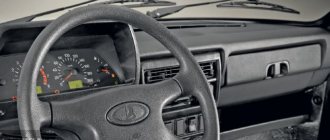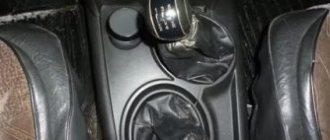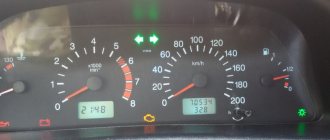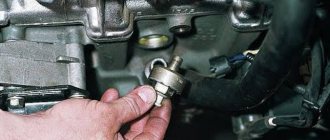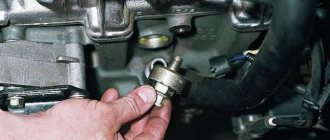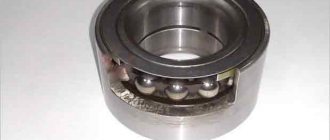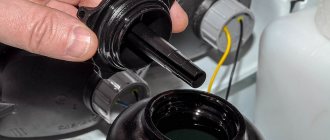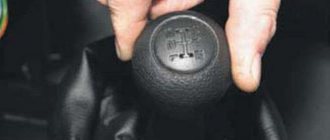Causes of car jerking
The first is a “cold start”, the car’s engine did not have time to warm up from the moment it was started until it started driving, which is typical at low temperatures in winter.
The second reason why the car began to twitch is the driver’s inability to properly operate the manual transmission. A manual transmission requires certain skills; if a driver has only used an automatic transmission, then he is unlikely to use a manual transmission and drive with ease. There is not enough knowledge here that when engaging reverse gear you need to turn the lever “here”.
Impact of jerks on the car
Whether jerking the car is beneficial or harmful is a rhetorical question. It’s the same as poking a person with a knife and asking if your health is improving. Any kind of jerking of the car is harmful, be it just a jolt when driving or a consequence of changing gears.
The main impact falls on the transmission unit and the engine part. First of all, the load on moving elements (bearings, switches, gears) increases. Each impact can deform, leave a crack or completely break any of these elements. Repairs can take a long time and cost the car owner a significant amount of money. That is why it is important to initially determine the reason why the car began to twitch and eradicate it.
The car jerks due to engine problems
Let's look into the heart of the car - the engine. What could be the reason why the car jerks when changing gears?
The first reason for engine operation may be uneven fuel distribution, which leads to instability in the movement of the power unit. Jerking of the car can also indicate unstable operation of the cylinders. In this case, the whole reason lies in the spark plugs. A low-quality or worn-out spark plug does not ignite mixtures in the cylinder well, and therefore disrupts its operation.
We should not forget about the human cause of problems with engine operation. Jerks when shifting gears can occur when the quality of the fuel is low. Remember that by saving on fuel and lubricants, you do not save on repairing your car.
If we consider modern injection engines, there may be many more reasons. The operation of such a motor is fully automated to increase the efficiency of the indicators. Yes, injection internal combustion engines are economical, easy to start and operate reliably, but diagnosing a malfunction is much more difficult. The main reasons for car jerking can be either the failure of one of the sensors or the wear of any element. Let's look at some of them:
- a malfunction of the on-board computer indicates a breakdown of the speed sensor;
- worn cables that do not allow fuel to be ignited on a regular basis for stable engine operation;
- clogs in the injector nozzles, interfering with the flow of fuel;
- idle speed sensor failure.
But the cross-country ability is good
This car is for those who need good off-road performance at a (relatively) low price. Another plus: the simplicity of the design and the availability of spare parts allow you to independently eliminate many minor deficiencies.
So, despite the factory miscalculations and outdated design, there are plenty of people willing to buy the Niva.
- The history of Niva modernization is here.
- When getting ready for a trip, check whether all your belongings will fit in the trunk and interior of the car. If in doubt, come to us for a car box! - current and wide range, discounts on purchases, installation and delivery. No storage space? Rent a car box!
- If you need to protect your car radiator from stones and other troubles, you can always make a protective mesh with your own hands or install a model radiator protection.
Humble yourself - this is Niva! 4 “proprietary” problems in the transmission
The car jerks due to faults in the manual transmission
For normal movement of a car with a manual transmission, constant gear shifting is required. The main rule of manual cars is to switch the lever on the box in time and correctly. If you violate the sequence, you can quickly wear out the parts and simply bring the car in for repairs.
In the case of a manual transmission, when changing gears, the car jerks due to the actions of the driver. What should you not do if you are still driving a manual car? First of all, it is necessary to choose the right time to press the clutch pedal and change gears. Do not delay the transition to high gears, and after switching to it, avoid sharp pressure on the gas pedal. The most important thing is that there is no need to press the pedals randomly at speed; every action should be thought through or you will cause damage to your car.
Other breakdowns
In addition to vibration, other problems may arise with the transfer case. The most common problem is with differential locking. The reason is damage to the teeth of the small ring of high and low gears. Inspect the parts, in some cases it is enough to simply clean the crown; in case of severe damage, you will have to replace it.
The lack of differential locking occurs due to severe deformation of the splines and other drive parts. The most reliable way to eliminate it is to replace damaged structural elements. The problem may also lie in the stretching of the clamp springs.
Another common problem is oil leakage. Most often this happens due to damage to the sealing gaskets. Sometimes after winter they can crack and do not provide a sufficient level of tightness. Leaks can also occur through seals. If leaks occur, replace damaged consumables.
Conclusion
. Domestic SUVs perform quite well on roads with different surfaces. But quite a lot of problems can arise with them. For example, a knock in the transfer case of the new Chevrolet Niva. This problem is not uncommon. Therefore, every owner of such a car should know the causes of this problem.
A car with an automatic transmission jerks when driving
Car diagnostics were not invented to suck money out of unknowing car enthusiasts - first of all, it is an opportunity to identify upcoming breakdowns and eliminate their occurrence before the car has to be “hospitalized.”
If a car with an automatic transmission jerks when driving, then the first reason may indeed be hidden in the low air temperature. This occurs due to freezing (thickening) of the oil; preheating will save the car.
Your car may be jerking because it simply doesn't have enough oil. Check its level, it is possible that the reason lies there.
The third reason also lies in the oil. Remember the last time it was changed. Regular replacement will help avoid many problems in car operation.
avtoexperts.ru
From time to time, every car owner is faced with a situation where the vehicle begins to jerk when starting to move when pressing the gas pedal or driving at low speeds. This behavior of the car is often caused by not too serious disturbances in the operation of the internal combustion engine and other systems. However, they need to be diagnosed and eliminated as soon as possible. Otherwise, they can lead to a complex breakdown, which will take a lot of time and money to fix.
When can a car “jerking” appear and what are the causes of the phenomenon?
In the vast majority of cases, the symptom of unstable driving can be diagnosed in the following situations:
• While the vehicle is starting to move (pushing away).
• During slow driving at low engine speeds.
• If necessary, accelerate suddenly while driving on the road.
• While the power unit is operating at high speeds.
In addition, the described behavior of the vehicle may also occur in other operating modes. The reason for this may be malfunctions of the following systems and components of the machine:
1. System for supplying the fuel mixture to the combustion chamber.
2. Ignition system.
3. Incorrect operation of the transmission.
4. Malfunctions in the operation of the car's electronic engine control unit.
How to troubleshoot?
Let's take a closer look at the main and auxiliary systems of the car, which can cause the vehicle to “jerk” while driving. We will also focus on how to eliminate diagnosed problems.
Fuel mixture supply system
Quite often, the cause of unusual behavior of a car while driving is improper operation of the fuel supply system to the engine or the injection system of the air-fuel mixture into the combustion chamber. In other words, the internal combustion engine cannot obtain the required amount of gasoline or diesel fuel. As a result, there is not enough torque from the shaft to transfer mechanical force to the suspension, and you end up with a dip in power.
To get rid of troubles, you need to:
• Check the operation of the throttle assembly.
• Test the functionality of the idle speed sensors.
• Check the correct position of the throttle valves.
• Check the functionality of the mass air flow sensor.
In most cases, the defect is found in the injectors, which are responsible for injecting the fuel mixture. Less commonly, an uneven ride is associated with the air passages that connect the injector and the air filter. Depressurization is possible, which leads to loss of pressure.
The problem found can be corrected by replacing damaged parts. You can do this yourself, but it is better to seek help from service center specialists. After carrying out the work, it is important to additionally check the tightness of connections along all fuel and air supply lines.
The car is shaking, what should I do?
At the first stage, the machine is diagnosed. Let's say that you have a Niva with a carburetor engine in your garage. Your car already shows signs of “illness” at the first stage of movement. Or the car started moving without any hassle, but when a certain number of revolutions was reached, the engine malfunctioned. All this will not give answers, but only creates questions, because anything can break. In any case, if unstable operation of the car’s power unit is noticed while pressing the accelerator pedal, the first thing you should do is:
- Check air and fuel filters. The supply of air and fuel to form a combustible mixture will be difficult if these elements are heavily contaminated.
- Check the fuel pump. Its incorrect operation leads to unstable fuel supply.
- Check fuel pressure. The supply of the fuel-air mixture under insufficient pressure often leads to jerking of the car. The pressure when the engine is running should not exceed 3 kgf/cm2.
Causes of car jerking
The first is a “cold start”, the car’s engine did not have time to warm up from the moment it was started until it started driving, which is typical at low temperatures in winter.
The second reason why the car began to twitch is the driver’s inability to properly operate the manual transmission. A manual transmission requires certain skills; if a driver has only used an automatic transmission, then he is unlikely to use a manual transmission and drive with ease. There is not enough knowledge here that when engaging reverse gear you need to turn the lever “here”.
The car jerks due to engine problems
Let's look into the heart of the car - the engine. What could be the reason why the car jerks when changing gears?
The first reason for engine operation may be uneven fuel distribution, which leads to instability in the movement of the power unit. Jerking of the car can also indicate unstable operation of the cylinders. In this case, the whole reason lies in the spark plugs. A low-quality or worn-out spark plug does not ignite mixtures in the cylinder well, and therefore disrupts its operation.
We should not forget about the human cause of problems with engine operation. Jerks when shifting gears can occur when the quality of the fuel is low. Remember that by saving on fuel and lubricants, you do not save on repairing your car.
If we consider modern injection engines, there may be many more reasons. The operation of such a motor is fully automated to increase the efficiency of the indicators. Yes, injection internal combustion engines are economical, easy to start and operate reliably, but diagnosing a malfunction is much more difficult. The main reasons for car jerking can be either the failure of one of the sensors or the wear of any element. Let's look at some of them:
- a malfunction of the on-board computer indicates a breakdown of the speed sensor;
- worn cables that do not allow fuel to be ignited on a regular basis for stable engine operation;
- clogs in the injector nozzles, interfering with the flow of fuel;
- idle speed sensor failure.
Chevrolet Niva (2009+). In second gear the car jerks and jerks are possible in first
Reasons for jerking
Quite often, while operating a car with different types of gearboxes (both manual and automatic), the driver may notice the appearance of jerks in first gear, as well as in second. At the same time, in other gears the indicated jerks may be absent. There are also a number of cases where the problem is of a “floating” nature. In such a situation, jerks appear “cold” and/or “hot”, etc.
Let us immediately note that there are several reasons for the appearance of such a malfunction, starting with the engine power system and ending with the transmission itself. In this article, we will focus on the gearbox, and also look at why the car jerks in first gear, why jerks occur in second gear, and what to look for when diagnosing problems.
The car jerks in first gear or second speed: fault diagnosis
As mentioned above, in such a situation, the first step is to gradually eliminate problems in the power supply system, ignition, as well as failures in the ECM. For example, a common reason when the car jerks at low speeds when engaging first and/or second gear is insufficient fuel/air supply to the engine or impaired mixture formation.
The result is that the engine is unstable, the unit in different modes does not have enough power to “turn” the box, which leads to noticeable jerks in movement. The culprit of the problem may be air leaks, contamination of the injection nozzles or fuel pump mesh, or problems with the carburetor. Various ECM sensors (Hall sensor, TPS, mass air flow sensor, etc.) can also malfunction. If everything is fine with the sensors, then you need to check the engine ECU. Quite often, the problem of jerking in 1st-2nd gear is directly related to the ignition. It is necessary to check the condition of the spark plugs and high-voltage wires, distributor and other elements on a particular machine.
As a rule, if the car drives jerkily, in relation to injection cars, specialists conduct comprehensive computer diagnostics of the engine. If such a check does not produce results or the cause is not found, then the vehicle’s transmission deserves special attention.
So, if your car is noticeably jerky in 1st and/or 2nd gear, it is important to understand that the transmission may also be causing the car to jerk when driving. At the same time, it is easier to determine the cause in the case of a manual transmission, while various types of automatic transmissions require more serious checks. Let's start with the manual transmission. Please note that if an inexperienced driver's car jerks in first gear when starting off, it should be taken into account that often beginners simply make mistakes when releasing the clutch, while the car itself is working properly.
To start without jerking, you need to smoothly release the clutch before the driver feels the grip point (the beginning of the transmission of torque from the engine to the wheels). After the force begins to be transmitted to the wheels and the car begins to move, you need to carefully add gas, dosing the traction with the pedal accelerator.
If an experienced driver is driving, then he can quickly identify the problem. So, on cars with manual transmissions, the gearbox itself often has nothing to do with the problem of jerking in gears when driving. In other words, in cases of gearbox failure, other problems are noted when the gears may not engage, grinding, humming, vibration of the gearbox, etc. appear. But jerking is usually caused by problems with the clutch on the manual transmission or its adjustments. For example, a car jerks in first and second when the clutch driven disc is badly worn, the clutch does not “close” completely, and slips. This leads to the car jerking when changing gears.
In this case, jerks most often appear precisely in “low” gears (first, second speed), when the smoothest possible operation of the clutch is needed and at the same time, through the clutch in these gears, a sufficiently large torque is transmitted from the internal combustion engine to the gearbox when accelerating the car.
Now let's move on to automatic transmissions. First of all, you need to take into account that the quality of operation and smoothness of automatic transmission shifts will depend on the type of automatic transmission. First of all, jerking can occur when driving with robotic gearboxes that have both one and two clutches. The fact is that the clutch of such gearboxes resembles in its design and principle of operation a conventional friction clutch of a manual transmission. Often the solution to the problem is to replace the DSG or AMT clutch, after which it is imperative to adapt the clutch (training, setting the grip point).
Also, in some cases, the culprit that the car jerks when driving in 1-2 gears may be breakdowns and malfunctions in the actuators that are responsible for the operation of the clutch in automated mode.
As for CVT variators and hydromechanical automatic transmissions, in this case, when jerking occurs, in-depth diagnostics are required. The fact is that such gearboxes do not have a traditional clutch. In this case, the automatic transmission clutch is a separate device (torque converter), where torque is transmitted through transmission oil. In this case, the gas turbine engine may well fail, which becomes the cause of jerking. It should also be noted that the automatic transmission itself can “slip”, and the quality of its operation greatly depends on the level/condition of the transmission oil (ATF fluid). Jerking in automatic transmissions of this type may occur due to insufficient or overfilled oil, the use of a lubricant with unsuitable properties, etc.
Jerking in a car with an automatic transmission in certain gears (especially during shifts) may indicate problems with the brake band, valve body, automatic transmission solenoids, sensors, separate automatic transmission ECU, etc. Taking into account the above, we can conclude that the machine needs to be checked comprehensively, paying special attention to the level of lubrication and the quality of the oil itself.
Eventually
If the car jerks in first gear or the car jerks in second gear, there can be many reasons. If we talk about the transmission, often with manual transmissions and many types of robotic gearboxes, a common cause is a worn clutch (both as a whole and individual elements) or malfunctions in the actuators responsible for the operation of the clutch on a manual transmission.
Manual transmission additives We also recommend reading the article about what an additive for a manual transmission is. From this article you will learn about the purpose and features of various additives for manual transmissions, as well as when to optimally use them. In the case of hydromechanical automatic transmissions, diagnostics are greatly complicated by a large number of sensors and the presence of a torque converter, which is a separate element. For this reason, it is recommended to carry out comprehensive computer diagnostics of the automatic transmission, as well as perform a number of tests and checks, which are carried out by experienced automatic transmission repair specialists at specialized service stations. Finally, we note that if the owner notices that the car begins to jerk in first gear, the car jerks in second speed, etc., it is better not to delay in determining the cause. On the one hand, quick troubleshooting will allow you to avoid more serious problems and costly breakdowns, but on the other hand, jerking and jerking in the first and second gears can cause accidents and other troubles on the road.
content .. 40 41 42 43 ..
The car jerks due to faults in the manual transmission
For normal movement of a car with a manual transmission, constant gear shifting is required. The main rule of manual cars is to switch the lever on the box in time and correctly. If you violate the sequence, you can quickly wear out the parts and simply bring the car in for repairs.
In the case of a manual transmission, when changing gears, the car jerks due to the actions of the driver. What should you not do if you are still driving a manual car? First of all, it is necessary to choose the right time to press the clutch pedal and change gears. Do not delay the transition to high gears, and after switching to it, avoid sharp pressure on the gas pedal. The most important thing is that there is no need to press the pedals randomly at speed; every action should be thought through or you will cause damage to your car.
The device of the VAZ Niva transfer case
The transfer case is not present in all VAZ passenger cars, but only on cars with two drive axles. In the transmission, the transfer case (TC) is installed at the rear of the gearbox; a rear driveshaft is attached to its shank, which connects the transfer case to the rear axle. The front axle is also driven by the LCD; it is connected to the transfer case by a front driveshaft.
The reduction gear in the Republic of Kazakhstan is designed to obtain high torque, it is used to overcome difficult sections of the road, and helps to cope with off-road conditions. The VAZ Niva transfer case contains the following main parts:
- the body itself;
- front axle drive shaft;
- intermediate shaft;
- drive shaft;
- gears;
- bearings;
- differential housing;
- satellites;
- differential lock clutch;
- gear shift clutch;
- flanges (for connection to cardan shafts);
- oil seals;
- control levers.
A car with an automatic transmission jerks when driving
Car diagnostics were not invented to suck money out of unknowing car enthusiasts - first of all, it is an opportunity to identify upcoming breakdowns and eliminate their occurrence before the car has to be “hospitalized.”
If a car with an automatic transmission jerks when driving, then the first reason may indeed be hidden in the low air temperature. This occurs due to freezing (thickening) of the oil; preheating will save the car.
Your car may be jerking because it simply doesn't have enough oil. Check its level, it is possible that the reason lies there.
The third reason also lies in the oil. Remember the last time it was changed. Regular replacement will help avoid many problems in car operation.


